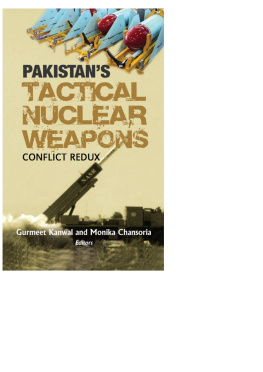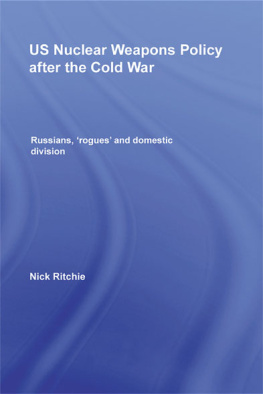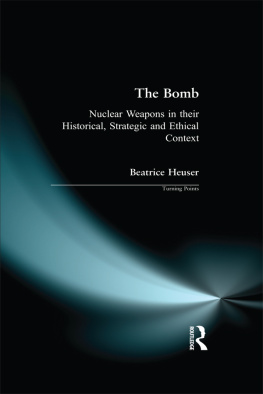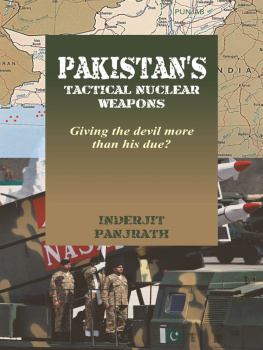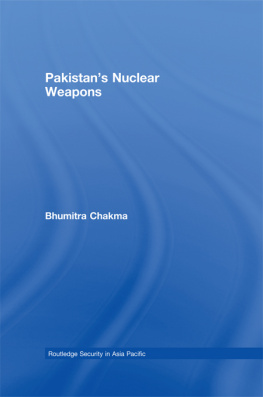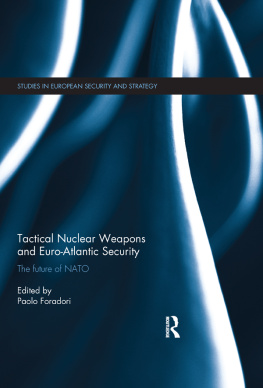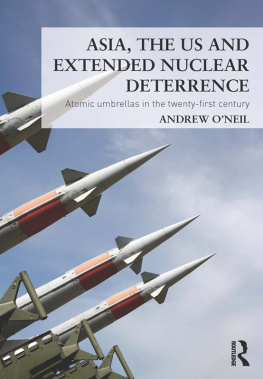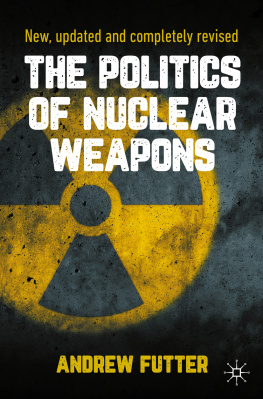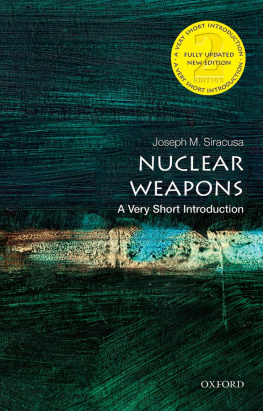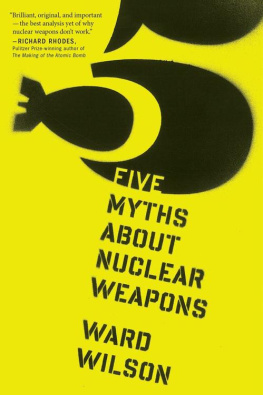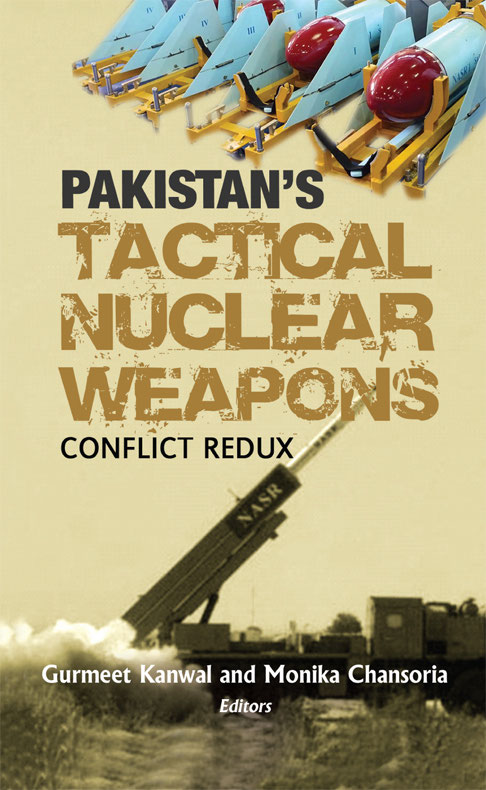PAKISTANS TACTICAL
NUCLEAR WEAPONS
CONFLICT REDUX
PAKISTANS TACTICAL
NUCLEAR WEAPONS
CONFLICT REDUX
Brig Gurmeet Kanwal(Retd)
Dr Monika Chansoria
Editors
The Centre for Land Warfare Studies (CLAWS), New Delhi, is an autonomous think tank dealing with contemporary issues of national security and conceptual aspects of land warfare, including conventional and sub-conventional conflicts and terrorism. CLAWS conducts research that is futuristic in outlook and policy-oriented in approach.
Centre for Land Warfare Studies
RPSO Complex, Parade Road, Delhi Cantt, New Delhi 110010
Tel: +91.11.25691308 Fax: +91.11.25692347
Email: landwarfare@gmail.com Website: www.claws.in
Copyright 2014, Centre for Land Warfare Studies.
All rights reserved. No part of this publication may be reproduced, stored in a retrieval system, or transmitted in any form or by any means, electronic, mechanical, photocopying, recording or otherwise, without the prior written permission of the copyright owner.
Disclaimer: The contents of this book are based on the analysis of materials accessed from open sources and are the personal views of the author. The contents, therefore, may not be quoted or cited as representing the views or policy of the Government of India, or Integrated Headquarters of MoD (Army), or the Centre for Land Warfare Studies.
ISBN 978-93-81904-76-3
eISBN 978-93-85714-67-2
Published in India by
Kalpana Shukla
KW Publishers Pvt Ltd
4676/21, First Floor, Ansari Road, Daryaganj, New Delhi 110002
Tel: +91.11.23263498 / 43528107 Email: knowledgeworld@vsnl.net
Website: www.kwpub.com
Contents
Dhruv C Katoch
Gurmeet Kanwal and Monika Chansoria
1.Scaring-up Scenarios: An Introduction
Bharat Karnad
2.Tactical Nuclear Weapons: A Step Closer to the Abyss
Vijay Shankar
3.Chinas Nuclear and Missile Transfers to Pakistan: Trends and Analysis
Monika Chansoria
4.Rationale and Implications
Kapil Kak
5.Logic and Options for Use
Arun Sahgal
6.Command and Control in the Context of Tactical Nuclear Weapons
Gurmeet Kanwal
7.Nuclear Command and Control Organisation: Political Problems
Sasikumar Shanmugasundaram
8.Technical Aspects of Hatf-9/Nasr Missile
Rajaram Nagappa
9.Safety and Security
Shalini Chawla
10.Indias Doctrinal Options
Rajesh Rajagopalan
11.Indias Response Options
Manpreet Sethi
Pakistans nuclear programme has been a source of concern not just for India but for the world at large. There is growing disquiet over the ever increasing number of nuclear weapons being developed by the state; when viewed in the light of Pakistans internal situation, such uneasiness gets magnified manifold. Today, Pakistan is facing serious security challenges, having to contend with a raging insurgency in its western provinces and serious ethnic and sectarian fissures in the rest of the country. This, in conjunction with the fact that society over the years has become increasingly radicalised, poses serious concerns for the security of Pakistans nuclear assets. Continuing politico-military instability in Pakistan heightens fears of a potential radical takeover of a government that possesses nuclear weapons, or for that matter, proliferation activities by radical sympathisers within Pakistans nuclear complex in case of a breakdown of controls.
A new element has now been added to these worries with Pakistans quest for Tactical Nuclear Weapons (TNWs). Pakistans ballistic missile, the Nasr, with a range of 60 km, is capable of carrying nuclear warheads of appropriate yield with high accuracy, shoot and scoot attributes. These have been built with the intention of targeting not only the Indian cities but Indian military formations on the battlefield. As per Maleeha Lodhi, Pakistans TNWs are aimed to counter balance Indias conventional military capability at the tactical level. Pakistans concern stems from Indias proactive military doctrine for which it presumably has no response, despite periodic assertions made by Pakistans military to the contrary. The number of TNWs required to halt an Indian offensive is large but the fact that they may be used opens up a whole new dimension of concerns, especially with respect to the possibility of nuclear escalation.
Given the range of the Nasr missile, the potential use of TNWs would dictate their deployment at the forward edge of the battlefield. They would have to be held at the corps level where chances of miscalculation, premature firing or partial discovery will remain invariably high, thus, requiring greater coordination and control. The use of TNWs is, however, treading on unchartered terrain and would likely raise fears all across the world of a potential nuclear conflagration in the subcontinent. Pakistans advocacy of use of TNWs even prior to engagement by conventional forces puts an ominous question mark on Pakistans Strategic Restraint Regime (SRR) proposal, with its element of nuclear restraint. Indias nuclear doctrine, on the other hand, places the use of nuclear weapons on the strategic and not on the tactical plane. This edited volume on Pakistans tactical nuclear weapons by Brig Gurmeet Kanwal (Retd) and Dr. Monika Chansoria is a comprehensive Indian take on various facets pertaining to the subject.
Maj Gen Dhruv C Katoch (Retd)
Director
Centre for Land Warfare Studies, New Delhi.
Gurmeet Kanwal and Monika Chansoria
Pakistans quest to acquire Tactical Nuclear Weapons (TNWs) has added a dangerous dimension to the already precarious strategic equation in South Asia. The security discourse in the subcontinent revolves around the perennial apprehension of a conventional or sub-conventional conflict triggering a chain reaction, eventually paving the way for a potential nuclear crisis, haunting peace and stability in the region.
The Pakistan Armys Directorate of Inter-Services Public Relations (ISPR) has announced the successful testing of the 60-km nuclear-capable short-range missile Hatf-9 (Nasr) declaring, Nasr can carry nuclear warheads of appropriate yield, with high accuracy and has been specially designed to defeat all known anti-tactical missile defence systems. This can be interpreted as an implicit signal to the region about Pakistans commitment to developing full spectrum deterrence including the use of TNWs.
While Pakistan believes that the Nasr adds deterrence value to Pakistans strategic weapons development programme at shorter ranges, it has, in fact, further lowered its nuclear threshold through the likely use of TNWs. Pakistan has not formally declared a nuclear doctrine, but it is well known that nuclear weapons are its first line of defence. Its presumed first-use policy is aimed at negating Indias conventional military superiority by projecting a low nuclear threshold. The use of TNWs in the India-Pakistan case will alter the strategic scenario completely as Pakistan would threaten India with the use of TNWs in the event of New Delhi responding against Islamabad with a conventional strike in reaction to a 26/11-style terrorist attack. According to the Pakistan Army, TNWs are designed to counter Indias Cold Start doctrine. Under this new policy, Indian troop formations need to be prepared to face Pakistani TNW strikes. What Pakistan is signalling to India and to the world at large, as per Shyam Saran, Chairman of Indias National Security Advisory Board, is that India should not contemplate retaliation even if there is another Mumbai-like terrorist incident because Pakistan has lowered the threshold of nuclear use to the theatre level. Saran identifies this to be nothing short of nuclear blackmail, which deserves equal condemnation by the international community because it is not just a blunt threat to India but to global peace and security.
Next page
